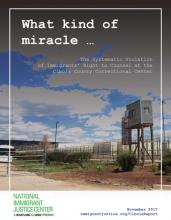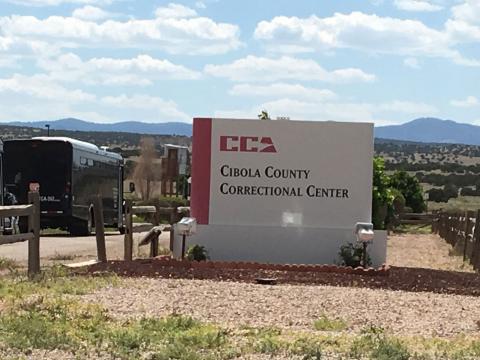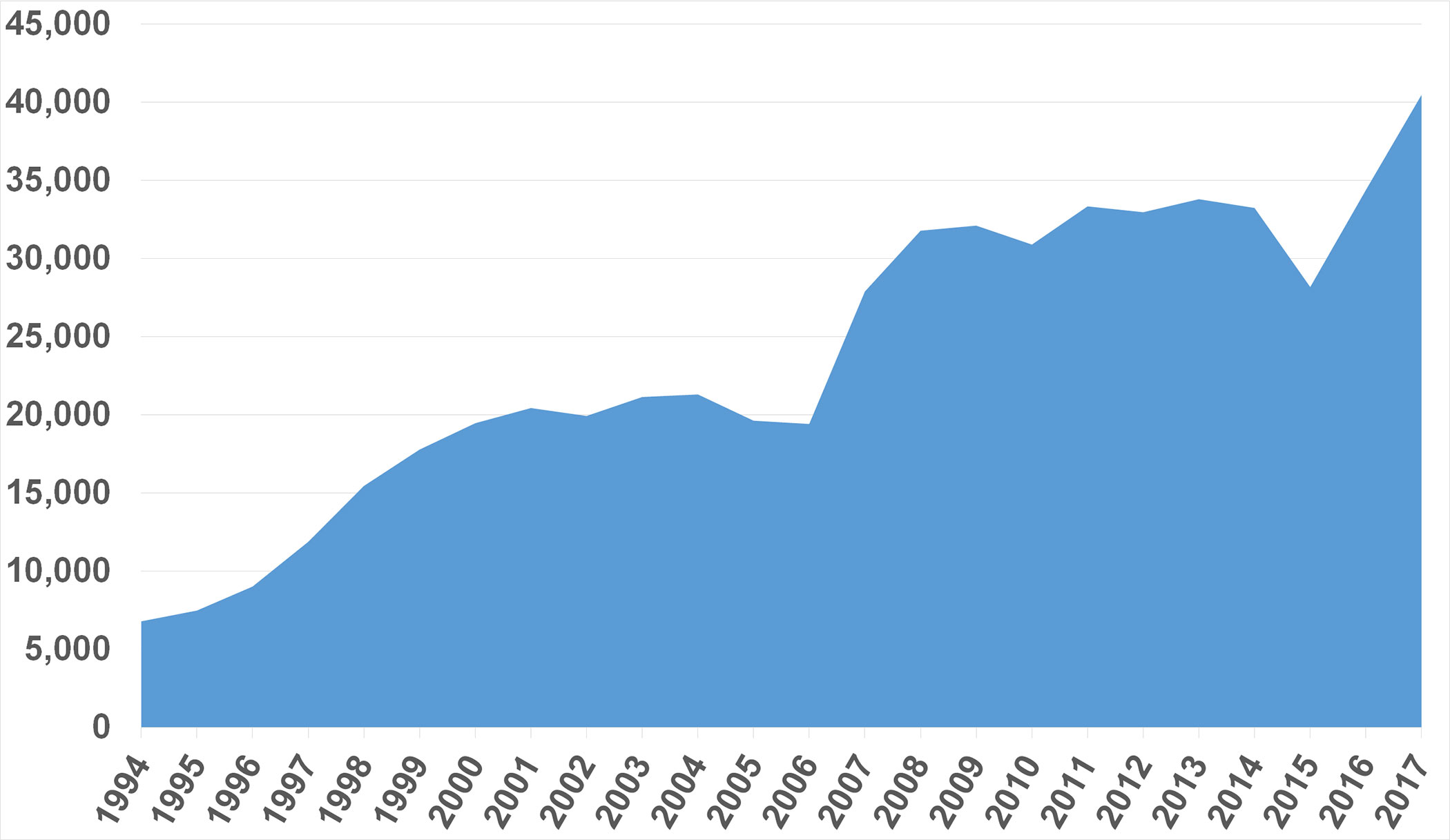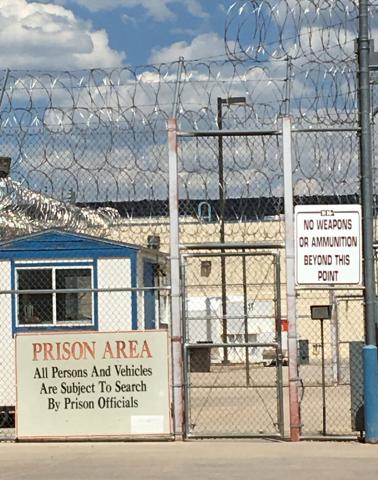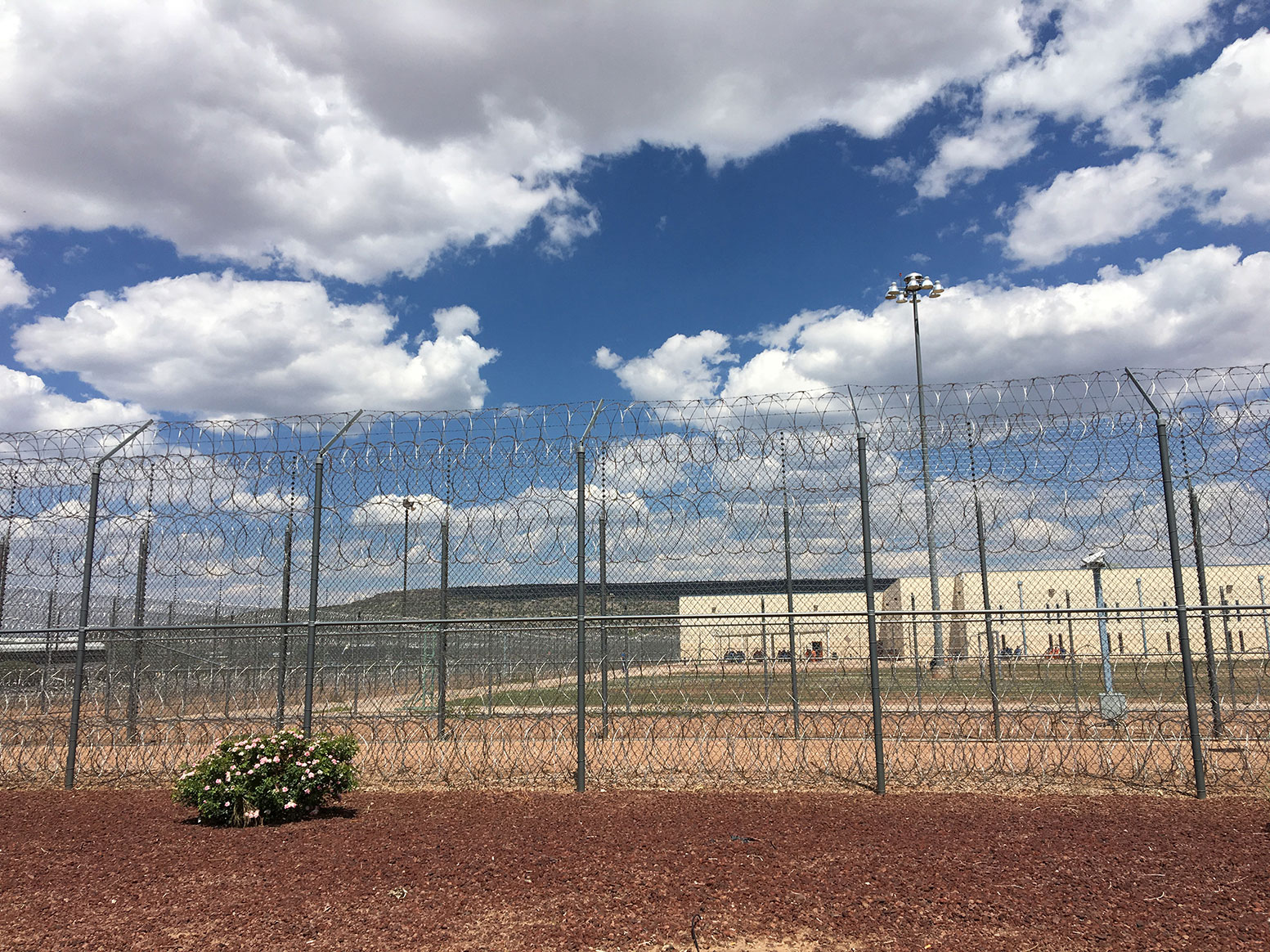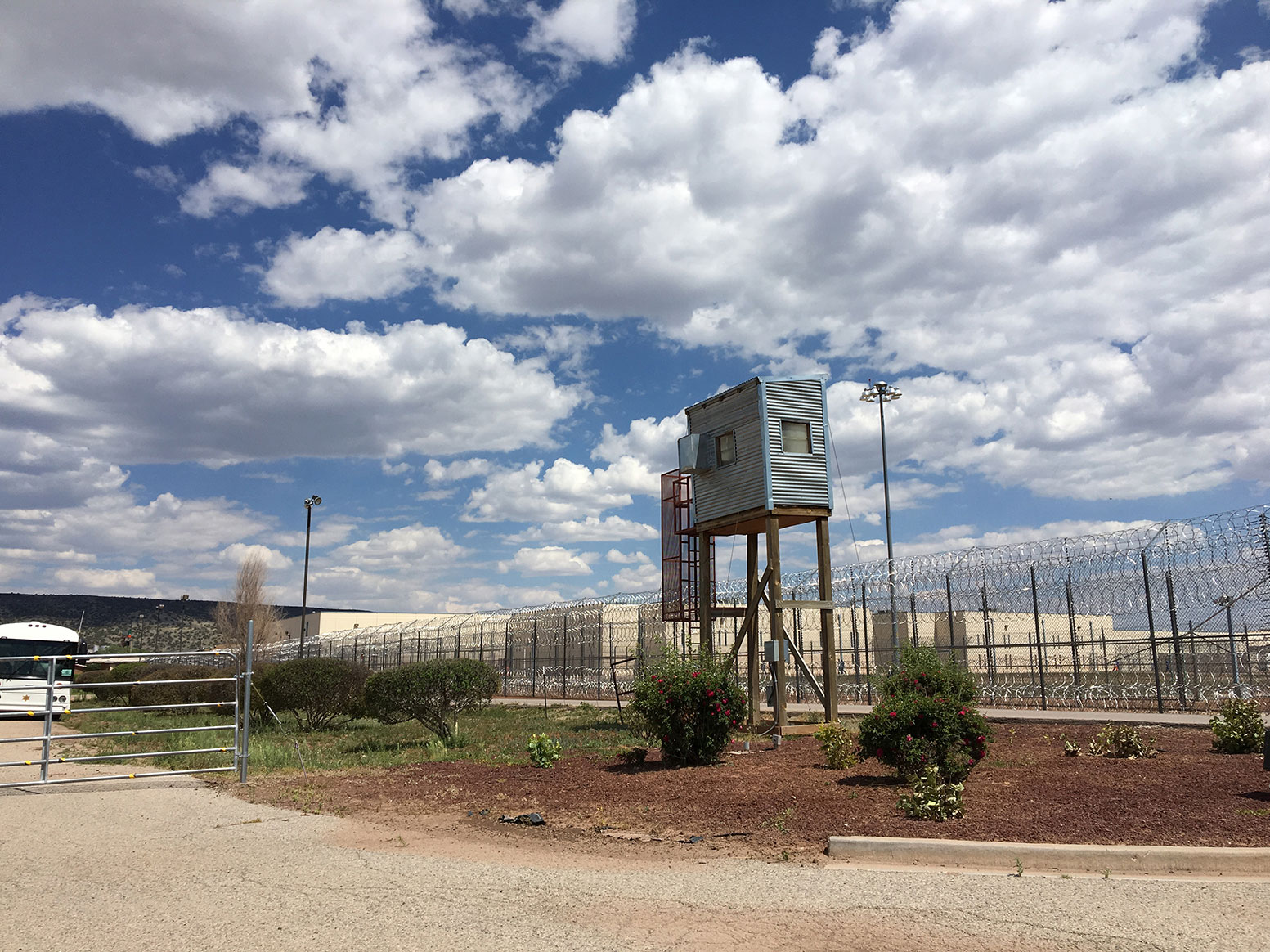“Yes, I don’t have any attorney yet because I’m still in prison here and … I don’t know what kind of miracle … I’m here as a prisoner. … I don’t understand anything, Madam.”
— Congolese asylum seeker jailed at the Cibola County Correctional Center, responding to questioning from an immigration judge
Introduction
When Donald Trump was elected president, the immigration detention system was already mired in such dysfunction that it routinely threatened the lives of those trapped inside. More than a year later, the administration intentionally uses its broken network of hundreds of immigration jails to advance an agenda that prioritizes mass deportation above respect for basic rights. This report focuses on the Cibola County Correctional Center, a prison complex in rural New Mexico owned and operated by the private prison giant CoreCivic (formerly Corrections Corporation of America)1 with the capacity to jail 1,100 immigrants facing deportation. Located far from any major urban center in a state with no immigration court, the prison has become a black hole of due process rights.
The National Immigrant Justice Center (NIJC) is particularly alarmed by the lack of meaningful access to counsel at the Cibola prison. Federal immigration law allows immigrants the right to counsel in deportation proceedings, but immigrants must locate and pay for it themselves. Immigrants detained in Cibola and many other immigration jails nationally are unable to avail themselves of this right because the capacity of nearby legal service organizations to provide representation is dwarfed by the need. An NIJC survey of legal service providers reveals that New Mexico and Texas immigration attorneys, at their maximum capacity, are only able to represent approximately 42 detained individuals at the Cibola prison at any given time — six percent of the jail’s population in April 2017. The due process violations occurring at Cibola and other Department of Homeland Security (DHS) prisons are the latest consequences of the Trump administration’s scheme to jail so many immigrants, and in such remote locations, that their right to representation is rendered meaningless.
An NIJC survey of legal service providers reveals that New Mexico and Texas immigration attorneys, at their maximum capacity, are only able to represent approximately 42 detained individuals at the Cibola prison at any given time - six percent of the jail’s population in April 2017.
In light of DHS’s systematic and willful rights violations, NIJC calls on the agency to close detention facilities like Cibola, where due process is non-existent given individuals’ lack of access to counsel, and demands that Congress immediately cut funding for DHS’s enforcement and detention operations. (See Recommendations.)
U.S. Immigration Detention National Average Daily Population from 1994 to 20172
Cibola’s Troubling History
The Cibola County Correctional Center is in northwest New Mexico, about a 90 minute drive from Albuquerque. It sits nestled in the sparsely populated village of Milan, just north of the El Malpais National Monument and east of the Zuni and Ramah Navajo Indian Reservations. Cell phone access is weak in the last few miles approaching the prison via Route 66.
The Cibola facility became an immigration prison on October 28, 2016, when Cibola County entered into an Inter-Governmental Service Agreement with DHS’s Immigration and Customs Enforcement (ICE).3 All funds obtained through the contract flow directly to CoreCivic, with the exception of a kickback of $.50 per day per person, which goes to the impoverished county.4 The contract provides for the detention of 1,100 individuals at a fixed rate of just over $2.5 million monthly, plus a “bed day rate” of $55.43 per day for each person jailed above a population of 847.5
Behind these numbers lurks a complicated history. Before converting the facility into an immigration prison, CoreCivic held federal criminal inmates there for 16 years under contract with the Bureau of Prisons (BOP).6 In July 2016, BOP terminated the contract after investigations revealed a history of unexplained deaths and rampant medical negligence at the facility.7 Within three months of BOP’s notification to CoreCivic of the contract termination, ICE and Cibola County had signed to keep the facility open as an immigration prison.8 During this interim period, CoreCivic’s Chief Executive Officer Damon Hininger shared on a quarterly stakeholder call his optimism that ICE’s interior enforcement efforts “could create demand for additional detention capacity,” and boost the company’s bottom line.9 Cibola County commissioners agreed to serve as a pass-through for the contract between ICE and CoreCivic without public scrutiny of the facility’s checkered history.10
Vulnerable Populations Behind Bars
The immigrants jailed at Cibola, as in the rest of the immigration detention system, include asylum seekers as well as undocumented and lawfully present immigrants who have lived in the United States for decades. All of them face removal proceedings and potential permanent exile from the United States.11
Many of those jailed at Cibola are in acute need of specialized medical and mental health services. For example, asylum seekers are more likely than not to suffer anxiety, depression, and/or post-traumatic stress disorder due to the harm and violence they have fled.12
Additionally, DHS maintains a dedicated unit for transgender women within the Cibola prison.13 Transgender immigrants are likely to be seeking asylum based on transphobic violence they have already faced or that they fear, and because of such histories are likely to suffer from depression, post-traumatic stress disorder, and other mental health conditions.14 Transgender women also are more likely to require specialized medical care including hormone replacement therapy and HIV treatment.15 The Cibola prison’s remoteness from legal advocates and its history of medical negligence are particularly alarming in light of these additional vulnerabilities.
No Lawyers for Miles
While the Cibola County Correctional Center illustrates many of the failings of the immigration detention system nationwide, this report highlights specifically the absence of meaningful access to counsel. NIJC surveyed nonprofit legal service providers near the prison, immigration attorneys throughout the state, and people detained in the prison (see Methodology). Their responses revealed that the vast majority of immigrants detained in Cibola are unable to avail themselves of their statutory right to counsel because there are simply not enough immigration attorneys near the prison to meet the overwhelming need.
Throughout New Mexico and Texas, NIJC identified only 21 attorneys – including free and low-cost legal service providers as well as members of the private bar – willing to take removal defense cases out of the Cibola prison. At their self-described maximum capacity, these attorneys would only be able to provide counsel to 42 individuals at the prison at any given time. This rate constitutes six percent of the prison’s April 2017 population of 689 (the most recent data made available by DHS) and less than four percent of the prison’s population were it to reach capacity.16
The depth and novelty of the need for legal services out of the Cibola prison has greatly taxed the region’s nonprofit immigration legal aid organizations. The New Mexico Immigrant Law Center in Albuquerque and the Santa Fe Dreamers Project work in partnership to provide legal education presentations and support to immigrants who are representing themselves in immigration court while detained at Cibola. No government funding is provided to either organization to support these presentations. Neither organization has capacity or dedicated funding to take on a significant number of direct representation cases on top of their non-detained work and legal education presentations. In fact, when the Cibola prison began detaining immigrants, the Santa Fe Dreamers Project had to divert many of its resources away from economic development projects for local immigrant communities in order to serve those in detention. Allegra Love, director of the Santa Fe Dreamers Project, recalls desperate rounds of phone calls to friendly lawyers who had never been in immigration court, begging them to take on even one asylum case. The New Mexico Immigrant Law Center was forced to engage in emergency grassroots fundraising to cover costs as basic as transportation for staff members to and from the prison.
The dearth of lawyers able to respond to the opening of a massive detention facility in Milan was not surprising; the New Mexico bar comprises only 51 attorneys who are members of the American Immigration Lawyers Association.17 There is no immigration court in New Mexico, and until Cibola began holding immigrants the only other immigration jails in the state were near the Texas border in Chaparral, New Mexico, and El Paso, Texas — hours away from the state’s population centers in Albuquerque and Santa Fe. Melissa M. Lopez, the executive director of the Diocesan Migrant and Refugee Services in El Paso, explained that her organization already is insufficiently resourced to meet the needs of the immigrants detained in those other detention centers, which continue to hold thousands of immigrants. Imelda Maynard, an immigration attorney at Catholic Charities of Southern New Mexico, explained that it was infeasible to regularly travel five hours to the Cibola prison from the organization’s office in Las Cruces. Attorneys in private practice described a landscape similarly limited in options and capacity, even for those detained at Cibola who are able to retain private counsel.
Frustration & Desperation
Within the Cibola prison, the scarcity of available services has created an environment of desperation and fear. Immigrants there have told NIJC that they appreciated the information offered during legal education presentations, but remained overwhelmed by the prospect of representing themselves in court. Many struggled to answer basic questions on immigration forms written in a language they could not understand, containing complex legal terms like “particular social group” and references to American legal statutes and international treaties.18
One young man who had spent 10 days at Cibola told NIJC that he intended to seek asylum because his political activism put his life in danger in his home country in Africa. But he found that at Cibola “there are free lawyers to give guidance but that there were no lawyers who would do representation in court.”
Another asylum seeker recalled making his way through the list of free legal service providers provided by DHS, feeling increasingly frustrated as some organizations never answered their phones and others said they could not take detained cases. NIJC was ultimately able to arrange for representation for this man through a major law firm in Denver, Colorado, who helped him prepare — and win — his asylum case. Remote legal representation of this sort requires a tremendous commitment of resources, however, and is unsustainable on a systemic scale. NIJC, which maintains a large pro bono representation program that relies on well-developed relationships with major law firms, has been able to arrange for remote pro bono immigration court representation for only three individuals at the Cibola prison.
The Cost of Long-Distance Pro Bono Representation19
NIJC worked with a Denver-based firm to represent three individuals at the Cibola prison this year. A pro bono attorney from that firm explains that the facility is an eight-hour drive from Denver, or requires a flight to Albuquerque, plus a car rental to drive another 90 minutes to Cibola. She estimates the firm has spent about 95 attorney hours traveling to and from the prison on three separate occasions for the three cases. With airfare, car rentals, hotel stays, and other travel expenses, these trips add up to thousands of dollars each.
A young Congolese man, Christopher20, was particularly upset about his inability to find a lawyer because the immigration judge had repeatedly advised him he should do everything possible to find one. The judge had recently denied Christopher’s asylum application despite his arduous journey to the United States to flee what he believed to be certain death in his home country. Christopher’s time in detention had been particularly challenging due to ongoing health struggles and a heightened sense of isolation because he speaks a rare indigenous language. NIJC accepted Christopher’s case on appeal (which does not require in-person representation) and was able to review his immigration court proceedings.
At Christopher’s first court hearing, the judge told him that “one of your most important rights is the right to have an attorney or other representative speak on your behalf.” Christopher replied (through an interpreter): “So now, right here, I’m in the jail. I’m in detention. I don’t know as an asylum [sic], I don’t know how things work here. In asylum, I have to stay in the jail. How am I going to get that attorney if I’m here?” When the judge asked him about the list of free legal service providers he had received from ICE he replied, “Okay, this list here, when you call people, they don’t answer. They don’t pick up the phone. A lot of people are calling them but nobody is picking up their phones.”
Over the course of Christopher’s immigration hearings, he described to the judge his ongoing health problems and his confusion as to how to complete basic tasks necessary to his self-representation, such as filling out the I-589 asylum application form. At one point Christopher pled, “I’m here as a prisoner. I’m here, I’m arrested as a criminal. And when I’m not – I don’t understand anything, Madam.” In the end, the immigration judge denied asylum largely on the basis of the ICE prosecutor’s argument that Christopher had not obtained corroboration of his claims of past harm – evidence he had been unable to obtain due to isolation and an inability to communicate with the outside world.
This situation is also grim, but in different ways, for women in the transgender housing unit at Cibola. That population has a higher probability of obtaining representation due to national programs, including NIJC’s LGBTQ Immigrant Rights Initiative, dedicated to the representation of transgender individuals. Additionally, many of the individuals in the unit had been transferred to Cibola from California after the Santa Ana City Jail stopped housing immigrants in May 2017; they had acquired lawyers before being transferred.21 For this population, although legal representation is statistically more likely, the mental health challenges of detention remain significant. Clients in this unit express desperation about being detained and frustration with the way the system works. One transgender woman at Cibola, represented by NIJC in a federal court appeal, has frequently remarked that it would be better to suffer the fast death that awaits her in Honduras than to suffer the slow death of immigration detention.
The Future of Immigration Detention: Why Cibola Matters
DHS paid little heed to the dearth of affordable legal services near Cibola when it entered its agreement with Cibola County and CoreCivic. Such a lapse is by no means new or unique. DHS has grown and maintained the immigration detention system in a manner incompatible with civil rights and due process protections.
In many ways, the Trump administration inherited an immigration detention system already riddled with abuse and neglect. Detained individuals, advocacy organizations including NIJC, and DHS’s Office of Inspector General have reported for decades on the profoundly inhumane conditions pervasive throughout the detention system, including: the excessive and arbitrary use of solitary confinement;22 inadequate, unsafe and spoiled food service;23 abuse of force by officers;24 and deaths attributable to medical negligence.25 Rather than assess possible reforms to address these problems—as the non-partisan Homeland Security Advisory Council advised in late 201626—the Trump administration quickly implemented changes that exacerbated existing harms. Today, DHS jails approximately 40,000 immigrants daily —more than any administration in recent history27— and holds them longer.28 The administration has publicly embraced the use of prolonged detention for asylum seekers29 and moved to weaken the standards governing conditions of detention.30
The administration seems poised to duplicate Cibola throughout the country. Its goal is clear: by undermining detained immigrants’ access to counsel, the administration ratchets up its removal rates.
Immigrants in detention centers throughout the country face the same frustrations as those jailed at Cibola when they try to find a lawyer. Nationally, fewer than one in every five immigrants in detention is able to find a lawyer.31 The Los Angeles Times recently reported that about 30 percent of detained immigrants are jailed more than 100 miles from the nearest government-listed legal service provider,32 with a median distance between the facility and the service provider of 56 miles.33
Access to counsel is important. Unrepresented, a detained immigrant, who often does not speak English, must develop her own legal arguments for relief eligibility, gather evidence that is often only available from within her country of origin (where she may fear for her own or her family’s safety), complete an application in English, and present a coherent presentation of her case to an immigration judge, all while a government-funded DHS prosecutor argues for her deportation.34 Faced with such a daunting task, immigrants enduring the isolation of detention are far less likely than those living in the community to defend against deportation and less likely to win their cases when they do so. The psychological harms caused by detention, especially for those with previous histories of torture or trauma,35 are so debilitating that even those with the strongest claims to legal protection in the United States often abandon the process and choose deportation instead.36 Detained immigrants with lawyers are 11 times more likely to pursue relief and are at least twice as likely to obtain relief as detained immigrants without counsel.37 A study analyzing the impact of appointed counsel for detained immigrants in New York City found a 1,100 percent increase in successful outcomes when universal representation became available..38
There is no doubt that DHS knows what it is doing. NIJC’s 2010 report Isolated in Detention documented the due process crisis already unfolding in the immigration detention system. At that time, NIJC found that 80 percent of detained immigrants were held in facilities that were severely underserved by legal aid organizations, with more than 100 immigrants for every full-time nonprofit attorney providing legal services.”40 The report presented eight recommendations to DHS and the Department of Justice to improve access to legal counsel for detained immigrants.41 Not one of the recommendations has been adopted or implemented by either agency.
Recently, DHS announced its interest in building new prisons in or near southern Texas; Chicago, Illinois; Detroit, Michigan; St. Paul, Minnesota; and Salt Lake City, Utah. The agency stated its goal was to increase the system’s capacity by up to 4,000 more beds.42 Legal aid organizations in these regions sent a letter to DHS explaining that they would have little or no capacity to provide meaningful access to counsel if the government carries out this expansion.43 As of publication of this report, DHS has not responded to this letter nor contacted any of the organizations to assess access to legal counsel.
The administration seems poised to duplicate Cibola throughout the country. Its goal is clear: by undermining detained immigrants’ access to counsel, the administration ratchets up its removal rates.
When the administration flaunts its record rates of deportations, it is telling a story of what happens to immigrants like Christopher and hundreds of others at Cibola who face insurmountable barriers to justice, not describing a legitimate outcome of enforcement of United States law. Jailing immigrants during their deportation proceedings makes it significantly more likely they will be deported, regardless of the merits or strength of their defense to deportation. At Cibola and prisons like it throughout the United States, incarceration has become another weapon in the administration’s arsenal, intended to facilitate mass removals no matter the cost to due process or civil rights.
Recommendations
DHS must close detention facilities like Cibola, where due process is non-existent given individuals’ lack of access to counsel.
Congress must cut appropriated funds for immigration detention, in light of the civil rights and due process crisis within the system.
Specifically, Congress must:
- Cease funding to detain individuals where there is no evidence of flight or security risk.
- Engage in robust oversight to ensure that when DHS does utilize detention, funding is only available for facilities where there is sufficient access to legal counsel (an established immigration bar) and adequate health care for individuals in detention.
A Note on Methodology
For the survey cited in this report, the National Immigrant Justice Center (NIJC) undertook a census of all the attorneys we could identify who regularly practice immigration law in New Mexico and Texas. The intent was to determine 1) the number of attorneys available to take immigration cases out of the Cibola County Correctional Center and 2) the maximum number of cases each attorney could take at a given time. NIJC staff identified all attorneys in New Mexico who, as of July 2017, were members of the American Immigration Lawyers Association (AILA), the primary membership association for immigration attorneys in the United States (identified using the membership directory at http://www.aila.org/member-directory). Through informal conversations with AILA members and legal aid organizations, NIJC staff added other New Mexico- and Texas-based attorneys to the list who were identified as providing even minimal legal representation at Cibola. NIJC staff and interns reached out to each of these attorneys via email and telephone. NIJC communicated directly via phone or email with an attorney or authorized staff person at all but nine of the 60 offices on the final list. Each attorney was asked whether they were able and willing to provide legal representation to individuals detained at Cibola, for a fee or on a low-cost or pro bono basis, and if so approximately how many cases they could take at maximum capacity. The detailed results of this census are on record with NIJC.
In addition to these census questions, NIJC staff held more extensive interviews with staff members at the following nonprofit legal service providers: Catholic Charities of Southern New Mexico (Las Cruces, NM); Diocesan Migrant and Refugee Services (El Paso, TX); Instituto Legal (Albuquerque, NM); Las Americas Immigrant Advocacy Center (El Paso, TX); the New Mexico Immigrant Law Center (Albuquerque, NM); and Santa Fe Dreamers Project (Santa Fe, NM). Additionally, in June 2017 NIJC staff members visited the Cibola prison, where they spoke with 12 individuals detained at the facility whose insights inspired and contributed to this report. Notes from these conversations are on record with NIJC. Notes from all of these conversations are on record with NIJC.
Acknowledgements
The principal authors of this report are NIJC Director of Policy Heidi Altman and NIJC Director of Communications Tara Tidwell Cullen, with research and editing contributions from NIJC colleagues Keren Zwick, Diane Eikenberry, Mary Meg McCarthy, Claudia Valenzuela, Julia Toepfer, and Isabel Dieppa. NIJC interns Linda Song and Anya Martin also contributed to this report. Sincere thanks for insights and support from Jessica Martin and Rebekah Wolf of the New Mexico Immigrant Law Center, Allegra Love of the Santa Fe Dreamers Project, Yazmin Ruiz of United We Dream, and the detained immigrants whose experiences are described in this report.
All photos credit the National Immigrant Justice Center.
Endnotes
- CoreCivic, previously known as the Corrections Corporation of America (CCA), has been described as “the world’s first private prison company.” See Madison Pauly, Mother Jones, “A Brief History of America’s Private Prison Industry,” July/Aug. 2016. For a harrowing recounting of the inner workings of the private prison industry, see Shane Bauer, Mother Jones, “My Four Months as a Private Prison Guard,” July/Aug. 2016.
- Sources for data points: Congressional Research Service, Immigration-Related Detention: Current Legislative Issues, Apr. 28, 2004 (for years 1994-2000); Congressional Research Service, Immigration-Related Detention: Current Legislative Issues, Jan. 12, 2012 (for years 2001-2012); Immigration and Customs Enforcement, Draft, Fiscal Year 2014 ICE Enforcement and Removal Operations Report (for years 2013-2014); U.S. Department of Justice, Report and Recommendations Concerning the Use of Restrictive Housing, Jan. 2016, p. 88; and Geneva Sands, ABC News, “Immigration-related arrests by ICE increase under President Trump,” Apr. 17, 2017 (for years 2016-2017).
- NIJC obtained the Cibola County intergovernmental service agreement and the county’s agreement with CoreCivic through a state open records request. The annotated documents are available online via NIJC’s Transparency Project.
- Rural New Mexico has some of the highest poverty rates in the nation, with Cibola County suffering the highest rates of unemployment in the state. See Rachel Sapin, Albequerque Business First, “Rural New Mexico has the highest poverty rates among all states’ rural areas,” Dec. 9, 2016. See the clause describing the kickback agreement.
- See supra note 3. Also see the contract clause showing the monthly and bed rates.
- See Seth Freed Wessler, The Nation, “The Feds Will Shut Down the Troubled Private Prison in a ‘Nation’ Investigation,” Aug. 15, 2016.
- See Seth Freed Wessler, The Nation, “Federal Officials Ignored Years of Internal Warnings About Deaths at Private Prisons,” June 15, 2016.
- Prison closures often present economic challenges for impacted communities. For an exploration of recent creative efforts across numerous states to repurpose prison buildings for new uses that bring economic opportunities, see Nicole D. Porter, The Sentencing Project, Repurposing: New Beginnings for Closed Prisons (Dec. 14, 2016).
- Michelle Mark, Business Insider, “Private prison companies are saying Trump’s immigration crackdown is looking good for business,” Aug. 9, 2017.
- Sarah Macaraeg, Reveal, “Inside a private prison’s $150M deal to detain immigrants in New Mexico,” Oct. 26, 2017.
- The Immigration and Nationality Act gives DHS authority to initiate removal proceedings against those seeking entry without permission, those present with authorization, and those who are lawfully present who ICE argues are subject to one of the statutorily delineated categories of removability which include relatively minor criminal offenses. These laws, greatly expanded in 1996, subject many to detention and deportation without judicial recourse. See Bobby Hunter and Victoria Yee, the Immigrant Justice Network and the New York University Immigrant Rights Clinic, Dismantle Don’t Expand: the 1996 Immigration Laws (May 2017).
- Allen S. Keller, et al., Lancet, “Mental health of detained asylum seekers,” Nov. 22, 2003.
- Jorge Rivas, Fusion, “How Trans ICE Detainees Ended Up in a Men’s Detention Center in the Middle of New Mexico,” June 5, 2017.
- Adam Frankel, Human Rights Watch, ‘Do You See How Much I’m Suffering Here?’ Abuse against Transgender Women in US Immigration Detention (Mar. 23, 2016).
- Id.
- The most recent detention population DHS has provided to NIJC for the Cibola prison was in a facilities matrix dated April 2017, available on the NIJC website. The maximum capacity of 1,100 is designated in the Cibola contract, see supra note 3.
- The 51 American Immigration Lawyers Association members from New Mexico were identified in November 2017 using the organization’s membership directory.
- For example, all applicants for asylum must complete the Form I-589, which includes 12 pages of questions and is provided in English. The form is available at https://www.uscis.gov/i-589. One of the many questions on the forms requires that the applicant identify whether the basis for her asylum application is race, religion, nationality, political opinion, “membership in a particular social group,” or the “Torture Convention.” This question alone can be endlessly confusing for non-native English speakers and English speakers without legal training. In a federal rule proposed by DHS but never finalized, the government itself described “particular social group” as “perhaps the most complex and difficult to understand of these five grounds. There is relatively little precedent about the meaning of ‘a particular social group,’ and that which exists has at times been subject to conflicting interpretations.” See Federal Register Publications (Legacy INS), Register Proposed Regulations, Asylum and Withholding Definitions, 65 FR 76588 (2000).
- Notes from this interview are on file with NIJC.
- “Christopher” is a pseudonym to protect confidentiality.
- See supra note 13.
- National Immigrant Justice Center and Physicians for Human Rights, Invisible in Isolation: The Use of Segregation and Solitary Confinement in Immigration Detention (Sep. 2012).
- Department of Homeland Security Office of Inspector General, Management Alert on Issues Requiring Immediate Action at the Theo Lacy Facility in Orange, California (Mar. 6, 2017).
- Southern Poverty Law Center and National Immigration Project, Shadow Prisons: Immigrant Detention in the South (2016).
- American Civil Liberties Union, Detention Watch Network, National Immigrant Justice Center, Fatal Neglect: How ICE Ignores Deaths in Detention (2016); Human Rights Watch, Systemic Indifference: Dangerous and Substandard Medical Care in U.S. Immigration Detention (May 2017), (examining “serious lapses in health care that have led to severe suffering and at times the preventable or premature death of individuals” in immigration detention).
- Homeland Security Advisory Council, Report of the Subcommittee on Privatized Immigration Detention Facilities (Dec. 2016).
- As of late August 2017, ICE detained an average of 38,153 people each day, a marked increase from the average daily detention populations of 2016 and 2015, which were 34,376 and 28,168 respectively. For 2017 data, see Ted Hesson, Politico, “Morning Shift: DACA sellout?,” Sep. 8, 2017. For data dating back to 1994, see supra note 2.
- As of September 2017, the average length of stay in an ICE facility was 44.4 days, according to information provided by ICE to Congress and shared with NIJC (email correspondence on file with NIJC). This compares to 34.9 days in 2016, 34.6 days in 2015, and 30.4 days in 2014. For historical data, see Department of Homeland Security Immigration and Customs Enforcement, FY2018 Congressional Budget Overview (2017).
- Human Rights First, Judge and Jailer: Asylum Seekers Denied Parole in Wake of Trump Executive Order (Sep. 2017).
- Caitlin Dickerson, The New York Times, “Trump plan would curtail protections for detained immigrants,” Apr. 13, 2017.
- Ingrid Eagly and Steven Shafer, American Immigration Council, Access to Counsel in Immigration Court (2016).
- The Department of Justice’s Executive Office for Immigration Review publishes state-by-state lists of free legal service providers on its website.
- Kyle Kim, Los Angeles Times, “Immigrants held in remote ICE facilities struggle to find legal aid before they’re deported,” Sept. 28, 2017.
- Daniel Epstein is an associate at the law firm of Jenner & Block and a pro bono attorney who takes deportation defense cases through NIJC. In a recent commentary piece for NIJC he described the “disorienting reality that detainees facing deportation don’t have a right to counsel.” He explains, “It’s disorienting because deportation defense cases look a heck of a lot like the kinds of proceedings in which you’d expect to have appointed counsel: the detainees are incarcerated pending the outcome of an adversarial proceeding in which they’ll face off against a trained attorney representing the government, and the consequences of losing can be effectively fatal. And yet—even though they are completely out of their element in a courtroom, and even though the stakes could hardly be higher—these detainees typically do not get an attorney. In some ways, it doesn’t feel American.”
- See generally The Center for Victims of Torture, The Unitarian Universalist Service Committee, and The International Torture Abolition and Survivor Support Coalition, Tortured and Detained: Survivor Stories of Immigration Detention (Nov. 2013).
- See, e.g., Martin Mendez Pineda, The Washington Post, “I’m a reporter in Mexico. My life is in danger. The United States Wouldn’t Give Me Asylum,” May 25, 2017.
- Eagly and Shafer, supra note 31.
- Vera Institute of Justice, Evaluation of the New York Immigrant Family Unity Project: Assessing the Impact of Legal Representation on Family and Community Unity (Nov. 2017).
- National Immigrant Justice Center, Isolated in Detention: Limited Access to Legal Counsel in Immigration Detention Facilities Jeopardizes a Fair Day in Court (Sep. 2010).
- Id. at pp. 5 - 6.
- Alan Gomez, USA Today, “ICE plans massive increase in federal immigration jails,” Oct. 17, 2017.
- National Immigrant Justice Center, et al., letter, “Response to RFI ‘Immigration Detention Services – Multiple Areas of Responsibility,’” Oct. 26, 2017.


